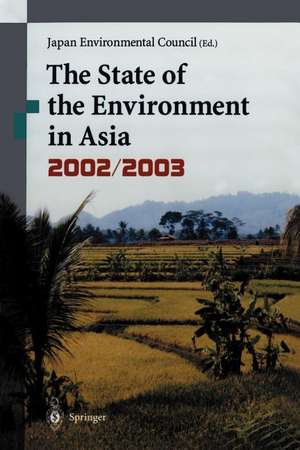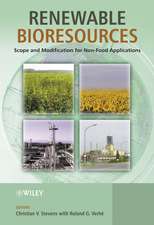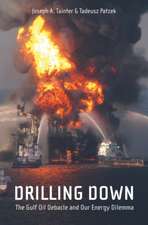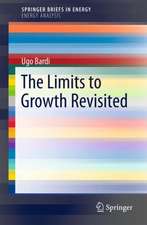The State of the Environment in Asia: 2002/2003
Editat de The Japan Environmental Council Takehisa Awaji, Shunichi Teranishien Limba Engleză Paperback – 18 noi 2002
Preț: 567.88 lei
Preț vechi: 709.85 lei
-20% Nou
Puncte Express: 852
Preț estimativ în valută:
108.67€ • 116.20$ • 90.60£
108.67€ • 116.20$ • 90.60£
Carte tipărită la comandă
Livrare economică 14-19 aprilie
Preluare comenzi: 021 569.72.76
Specificații
ISBN-13: 9784431703457
ISBN-10: 4431703454
Pagini: 384
Ilustrații: XXII, 361 p.
Dimensiuni: 155 x 235 x 20 mm
Greutate: 0.54 kg
Ediția:2003
Editura: Springer
Colecția Springer
Locul publicării:Tokyo, Japan
ISBN-10: 4431703454
Pagini: 384
Ilustrații: XXII, 361 p.
Dimensiuni: 155 x 235 x 20 mm
Greutate: 0.54 kg
Ediția:2003
Editura: Springer
Colecția Springer
Locul publicării:Tokyo, Japan
Public țintă
ResearchDescriere
In December 1977 we published the first in this series of NGO-oriented reports on Asia's environment, Ajia Kankyo Hakusho 1997/98. This was published in English by Springer-Verlag as The State o/the Environment in Asia 1999/2000. Although only a few years have passed since then, Asia has seen tumultuous changes in the political, economic, social, environmental, and other domains, as well as a number of prominerit trends that could be regarded as harbingers of the new century. China, for instance, could henceforth decisively affect the evolution of environmental problems not only in Asia, but across the entire globe. Yet Chinese concern for and initiatives on pollution and environmental damage have increased more quickly than could have been anticipated just a few years ago. And on Taiwan, where a Democratic Progressive Party president was elected over the long-ruling Nationalist Party, an attorney who has cooperated with our pollution surveys for a decade, Hsieh Chang-ting, became mayor of Taiwan's largest heavy and chemical industry city of Kaohsiung, where he has begun a "Green Revolution. " On the Ko rean Peninsula, which has for many years endured the division of its people, as well as political and military tensions, there are the beginnings of a new North-South dialog. These changes are all welcome to those of us who wish to see new advances in environmental cooperation throughout Asia.
Cuprins
I Asia by Theme.- 1 Energy Policies and Choices Put to the Test.- 1. Introduction.- 2. Energy Consumption Trends.- 3. Coal-Fired Thermal Development and the Environment.- 4. Nuclear Power Development and Increased Risk.- 5. Asia’s Environmental and Energy Policy Outlook.- Essay 1 Japan’s Global Warming Mitigation Measures and the Campaign to Promote Nuclear Power.- Essay 2 The Kyoto Protocol and North-South Equity.- 2 Mining and Its Environmental Damage.- 1. Introduction.- 2. Nonferrous Metal Mine and Smelter Development in East Asia.- 3. Japanese Involvement Throughout East Asia.- 4. Environmental Impacts of Mining and Smelting.- 5. Conclusion.- Essay 1 Asian Mining Pollution and the Japanese Experience.- Essay 2 Mercury Pollution on Mindanao, the Philippines.- 3 Wandering Wastes.- 1. Introduction.- 2. Municipal Solid Wastes.- 3. Industrial Wastes.- 4. Hazardous Wastes on the Move.- 5. Achieving a Cyclical Society.- Essay 1 South Korea’s Action on Dioxins.- Essay 2 Decommissioned Vessels Set Sail for the Developing World.- Essay 3 Toxic Wastes Dumped in Cambodia.- 4 Asia’s Marine Environment Hangs in the Balance.- 1. Introduction.- 2. Marine Pollution.- 3. Damage to Natural Resources.- 4. Marine Conservation Initiatives.- Essay 1 Little Progress on Fisheries Resource Management in Northeast Asian Waters.- Essay 2 Shrimp and Mangroves.- 5 Conservation and Local Self-Government.- 1. Introduction: Why the Focus on Local Self-Government?.- 2. Republic of Korea.- 3. Thailand.- 4. The Philippines.- II Asia by Country and Region.- 1 Republic of the Philippines.- 1. Introduction.- 2. Severe Deforestation.- 3. Environmental Consequences of Economic Growth.- 4. Development and Environment in the Cebu-Bohol Region.- 5. Legal System for Natural Resource Use and Environmental Protection.- 6. Conclusion: Getting the People Involved.- 2 Socialist Republic of Vietnam.- 1. Introduction: Doi Moi and the Environment.- 2. Background.- 3. Environmental Damage.- 4. Factors that Impede Solutions.- 5. Environmental Protection.- 6. Summation: Vietnam’s Challenge.- Essay 1 Impacts of Dioxins on Human Health in Vietnam.- Essay 2 Recycling in Hanoi.- 3 India.- 1. Introduction.- 2. Current Environmental Problems.- 3. Environmental Legislation, Administration, and Litigation.- 4. The Environmental Movement Tradition.- 5. Conclusion: Future Prospects.- Essay 1 Bhopal Revisited.- Essay 2 India’s Air Pollution.- 4 Country/Region Updates.- Japan.- 1. Environment Agency Becomes a Ministry.- 2. New Environmental Legislation and Policy.- 3. Pollution Litigation.- Essay 1 Metropolitan Tokyo’s Road Pricing Policy.- Republic of Korea.- 1. Environmental Policy since the Mid-1990s.- 2. Bigger Roles and Responsibilities for Local Governments.- 3. Development or Environment: Three Examples.- Kingdom of Thailand.- 1. Continuing Clash over Power Plant Projects.- 2. Inland Prawn Farming.- 3. Efforts to Amend the Enhancement and Conservation of National Environmental Quality Act of 1992.- Essay 2 Renewed Criticism of Multilateral Financing.- Malaysia.- 1. Trends on Peninsular Malaysia.- 2. Sabah and Sarawak States.- Indonesia.- 1. Forest Fires.- 2. Impacts of Forest Fires.- 3. Involving Local People.- People’s Republic of China.- 1. Enforcement Actions and the Need for Social Cooperation.- 2. Citizen Initiatives for the Environment.- 3. New Developments in Japan-China Environmental Cooperation.- Essay 3 China’s Environmental Problems as Seen from the Republic of Korea.- Essay 4 China’s Environmental Business and Diplomacy.- Taiwan.- 1. Hazardous Waste Management.- 2. Dam Construction and Opposition.- 3. Kaohsiung’s “Green Revolution”.- Essay 5 Black-Faced Spoonbill Faces Extinction.- Essay 6 Transportation and Air Pollution in Katmandu.- III Indicators.- 1. Income Differentials and Growing Consumption.- 2. Industrial Safety and Health.- 3. Health and Education.- 4. Reproductive Health/Rights and Population.- 5. The Late Starter’s Advantage and Detrimental Legacies.- 6. Biodiversity and Genetic Resources for Food and Agriculture.- 7. Wood Production and Trade.- 8. The State of Forest Resources.- 9. Fishing Effort Increase and Marine Fisheries Resources.- 10. Protected Areas.- 11. The Asian Wildlife Trade as Revealed by Japan’s Imports.- 12. Biodiversity.- 13. Rapid Urbanization.- 14. Motorization Rolls On.- 15. Expanding Mining Production and Damage.- 16. Municipal and Hazardous Wastes.- 17. Paper Recycling: The North-South Connection.- 18. Water Environment in Crisis.- 19. Nuclear Power Proliferation and Nuclear Weapons.- 20. Global Warming Policies and Joint Implementation in East Asia.- 21. Progress in Environmental Legislation.- 22. Environmental NGOs.- 23. Environmental Conventions and Agreements in Asia.- Notes.- References.- Translator’s Afterword.














